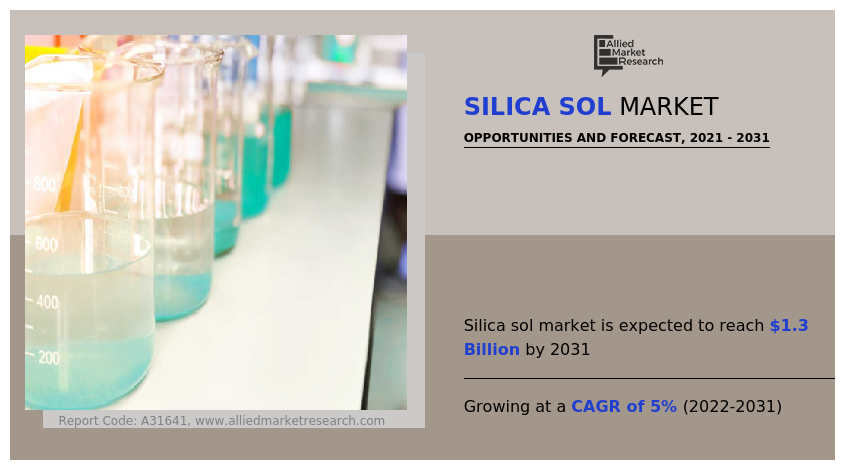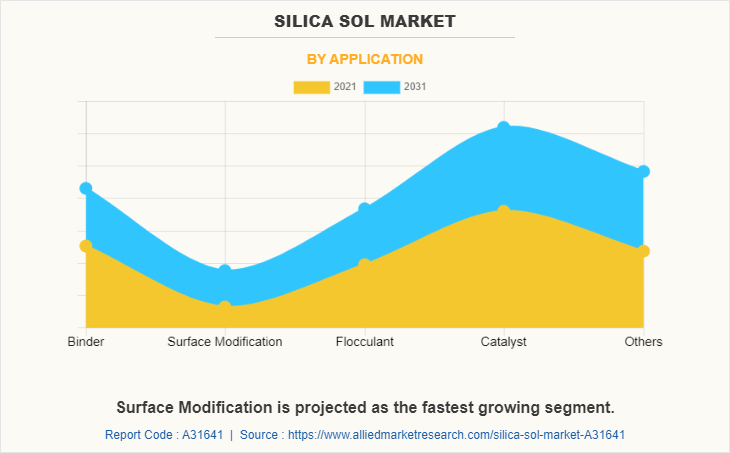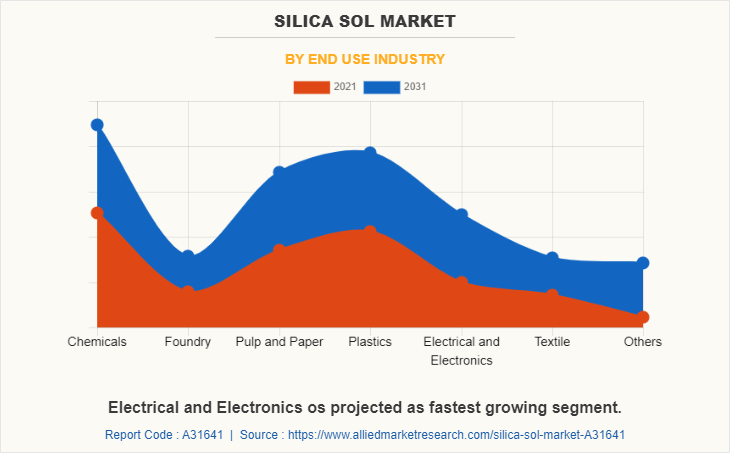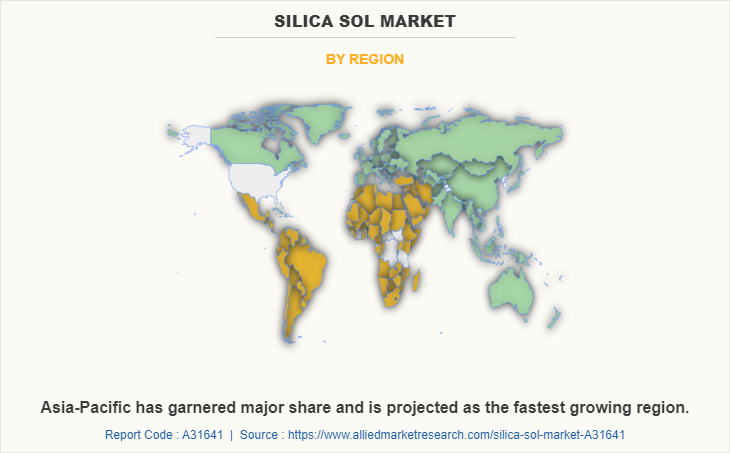Silica Sol Market Research, 2031
The silica sol market attained $0.8 billion in 2021 and is projected to reach $1.3 billion by 2031, growing at a CAGR of 5.0% from 2022 to 2031.
Silica sol is a dispersion of amorphous silicon dioxide (silica) particles in water. By polymerizing silica nuclei from silicate solutions under alkaline circumstances, nanometer-sized silica sols with a high surface area are generated. The surface of the silica nanoparticles is then charged, causing them to reject one another and form a stable dispersion, or colloid. There are various grades of colloidal silicas that vary in a number of characteristics. Depending on the manufacturing method, particle size distribution can range from narrow to broad. Standard colloidal silica is stable at pH values between 8.0 and 10.5, and its anionic surface charge is stabilized by salt or ammonium. In certain grades, a portion of the silicon atoms in the silica particle is replaced with aluminate ions to increase stability over a broader pH range, typically 3.5 to 10.5. Colloidal silica can also be manufactured with a stable positive surface charge in the acidic pH range. This is achieved by altering the particle's surface with aluminum and stabilizing its charge using chloride anion.

Silica sol continues to gain popularity as the favored abrasive in chemical mechanical planarization (CMP) applications because of its main characteristics, which include high stability and tunable particle size distribution. Recent research efforts aimed at developing colloidal materials with modifiable chemical and physical properties may pave the way for profitable opportunities in the silica sol business.
There has been a significant increase in the use of silica sol in the automotive sector for the production of tires with decreased rolling resistance to enhance vehicle control and fuel economy. In addition, the rising popularity of eco-friendly tires bodes well for the global sales of colloidal silica. Government rules governing the use of protective coatings have increased the automotive sector's usage of green coatings, which continues to boost the silica sol market. According to the International Organization of Motor Vehicle Manufacturers, the production of automobiles is increased. In 2020, it was $77 million, and $80 million in 2021. An increase in automobile production is expected to increase the demand for silica sol in the automotive industry and will drive the global silica sol market.
Stable, colloidal silica sol is produced by vigorously mixing a slurry of calcium silicate with a dilute acid with a pKa value of less than about 8, such as sulfuric acid, and then separating the sol from the insoluble calcium salt precipitate. Due to variations in raw material, compounding, filing, and processing costs, silica sol prices may also fluctuate substantially. High production costs may function as a hurdle to market expansion.
Rising investments by key players is expected to boost the demand
The market for silica sol is anticipated to experience growth opportunities as a result of rising investments in silica sol production by industry leaders. For instance, BASF announced in April 2019 that it will invest double-digit euro million in the renovation of its silica factory in Düsseldorf-Holthausen. The investment is designated for the enhancement and upgrading of current facilities in the years to come. This increased investment is anticipated to fuel the expansion of the silica sol market during the forecast period. Increasing R&D efforts by market participants to design innovative silica sol products with modifiable chemical and physical properties is expected to provide a lucrative opportunity for the market.
High price volatility of the raw materials used in the production of silica sol remains a major issue among industry participants. Due to the independent character of the product, the dependence of the silica sol market on cyclical end-use sectors has limited the expansion of the market to some extent. These factors act as challenges for the silica sol market.
The global silica sol market is segmented into application, end-use industry, and region. Depending on the application, the market is classified into a binder, surface modification, flocculant, catalyst, and others. On the basis of the end-use industry, it is categorized into chemicals, foundry, pulp and paper, plastics, electrical & electronics, textile, and others. Region-wise, the market is studied across North America, Europe, Asia-Pacific, and LAMEA.
The major players operating in the global silica sol market are ADEKA CORPORATION, AMS Applied Material Solutions, Cabot Corporation, Ecolab Inc., Evonik Industries AG, Gelest, Inc., Merck KGaA, Nissan Chemical Corporation, Sterling chemicals, W. R. Grace & Co.-Conn. Other players operating in the market are Nouryon, Visa Chemical Industries, and Qingdao FSK Foundry Materials CO., LTD.

The catalyst segment accounted for the largest share i.e., 28.64%, due to increased demand for innovative materials. Other segment which includes investment casting is expected to be the fastest growing segment, growing around 5.8% CAGR during the forecast period. This is due to the increased demand for power generation.

The chemicals segment accounted for the largest share i.e., 21.96% due to increased demand for silica sol in grouting applications. Other segment which includes building and construction is expected to be the fastest growing segment, growing around 7.2% CAGR over the forecasted period. This is due to the increased demand for silica sol as it is used in cement, flooring, mortars, asphalt mixes, skid-resistant surfaces, and other industrial materials to improve durability and structural integrity.

Asia-Pacific contributed 48.04 % market share in 2021 and is projected to grow at a CAGR of 5.9% during the forecast period, owing to the increased demand from plastic and textile industries.
COVID-19 impact analysis
The global automotive industry has been hit hard and fast by the COVID-19 pandemic as a result of its rapid spread. But after the pandemic, the automotive industry started to grow rapidly. The production of automobiles increases in 2021 as compared to 2020. According to the International Organization of Motor Vehicle Manufacturers, the production of automobiles is increased. In 2020, it was $77 million, and $80 million in 2021. An increase in the automotive industry is driving the silica sol market after the COVID-19 pandemic.
Key Developments & Strategies
- On June 15, 2020, W. R. Grace & Co., a chemical company headquartered in the U.S., opened its new 8,200 square-meter innovative colloidal silica plant at its flagship manufacturing and R&D center in Germany. This new development would help the company in doubling the global production capacity of its bestselling colloidal silica product named LUDOX, thereby significantly improving its responsiveness to customers present in Asia Pacific, as well as Europe, the Middle East, and Africa, (EMEA).
- On August 2, 2019, Evonik Business line silica introduced one new product for oral care the product is named SPHERILEX 145, which was launched to achieve a high cleaning level while offering lower abrasion to enamel as well as other oral hardware.
- On September 15, 2018, Evonik Industries, shared its plans to expand the company’s hydrophobic fumed silica capacities to cater to the growing demand for specialty silica varieties. The expansion aims at making 20% additional capacity for the refinement of hydrophilic silica available by the end of 2020.
Key Benefits For Stakeholders
- This report provides a quantitative analysis of the market segments, current trends, estimations, and dynamics of the silica sol market analysis from 2021 to 2031 to identify the prevailing silica sol market opportunities.
- Market research is offered along with information related to key drivers, restraints, and opportunities.
- Porter's five forces analysis highlights the potency of buyers and suppliers to enable stakeholders make profit-oriented business decisions and strengthen their supplier-buyer network.
- In-depth analysis of the silica sol market segmentation assists to determine the prevailing market opportunities.
- Major countries in each region are mapped according to their revenue contribution to the global market.
- Market player positioning facilitates benchmarking and provides a clear understanding of the present position of the market players.
- The report includes the analysis of the regional as well as global silica sol market trends, key players, market segments, application areas, and market growth strategies.
Silica Sol Market Report Highlights
| Aspects | Details |
| Market Size By 2031 | USD 1.3 billion |
| Growth Rate | CAGR of 5% |
| Forecast period | 2021 - 2031 |
| Report Pages | 250 |
| By Application |
|
| By End Use Industry |
|
| By Region |
|
| Key Market Players | Cabot Corporation, Merck KGaA, Sterling Chemicals, ADEKA CORPORATION, AMS Applied Material Solutions, W. R. Grace & Co.-Conn., Evonik Industries AG, Nissan Chemical Corporation, Ecolab Inc., Gelest, Inc. |
Analyst Review
According to the insights of the CXOs of leading companies, the increasing use of silica sol in the paper production sector to improve the frictional and printing qualities of board stock is a significant factor in the expansion of the silica sol market. Silica sol is also employed in water-based paints and coatings. These are appropriate for a variety of applications in both dry and damp environments. Several manufacturers are attempting to invest in paints and coatings in order to capitalize on the product's advantages, as they can reduce the environmental impact. Consequently, the growing demand for silica sol from a variety of end-use sectors will drive the silica sol market during the forecast period.
Increasing use in the pharmaceutical industry is the upcoming trend in the silica sol market in the world.
Electrical and Electronics industry is projected to increase the demand for Silica Sol Market.
Catalyst is the leading application of the Silica Sol Market.
Asia-Pacific is the largest regional market for Silica Sol.
AMS Applied Material Solutions, Cabot Corporation, Ecolab Inc., and Evonik Industries AG are the top companies to hold the market share in Silica Sol.
The silica sol market attained $0.8 billion in 2021 and is projected to reach $1.3 billion by 2031 by 2031, growing at a CAGR of 5.0% from 2022 to 2031.
Increased demand from the electrical & electronics industry is the Main Driver of the Silica Sol Market.
Loading Table Of Content...



